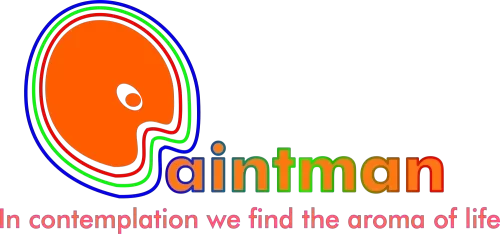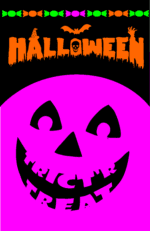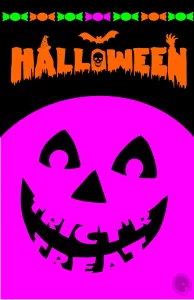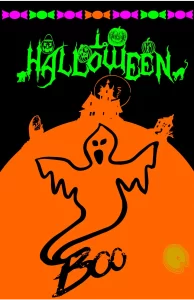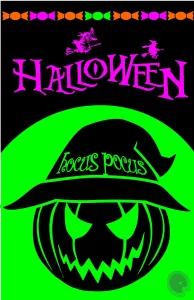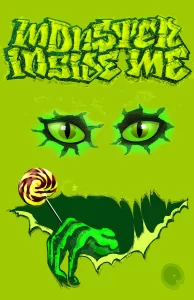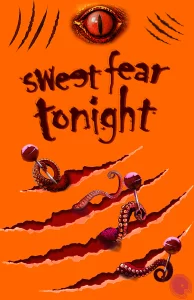Entangled in networks of crowds
A custom to hide the fear
Cultural celebrations and holidays enrich young spirits. The knowledge of traditions, customs and cultural learning helps the development of many advantages to a filled life. Access to multicultural sources and practices allows us to understand and empathize with new people. Mainly with the environment that surrounds us. When we transmit and reserve traditions, we get some personal benefits and an absolute impact on the dynamics of the regions. These advantages are the knowledge, the practice and sharing of the lores and mores of the place of birth. Or new lands that we adopt. Remember, the roots always require new substrates, for a leafy soul, strong and absorbent roots are required. Some of those advantages that nurture are the life lessons that come from other people’s experiences. The sense of identity and belonging. The proper strength of personal, familiar and national values. Hence, in this way, we can promote a respectful social and environmental coexistence. Individuals with more concerned about well-being for all who arm themselves with happy and magical tools to repel exclusion and fear of the unknown.
 It’s outstanding how people look forward to Halloween parties. We cannot deny the great esteem in the calendar. Like many other festivals in the Anglo-Saxon countries and others who share similar values. Halloween, without being a date of political value, nor even or a history day to pay tribute; continues to be one of the most expected seasons by the population. Especially for the more youthful attitude. Pumpkins carving, trick-or-treating, and wearing scary costumes are some of the most classical traditions of those days. The roots of the Halloween go back to the ancient pagan celebration of the Celts, where they welcomed the harvest after summer.
It’s outstanding how people look forward to Halloween parties. We cannot deny the great esteem in the calendar. Like many other festivals in the Anglo-Saxon countries and others who share similar values. Halloween, without being a date of political value, nor even or a history day to pay tribute; continues to be one of the most expected seasons by the population. Especially for the more youthful attitude. Pumpkins carving, trick-or-treating, and wearing scary costumes are some of the most classical traditions of those days. The roots of the Halloween go back to the ancient pagan celebration of the Celts, where they welcomed the harvest after summer.
 During that time on Samhain, which was the Gaelic term, people lit bonfires and dressed up to ward off ghosts. It was then, when in the eighth century, with the accession of Pope Gregory III, designated November 1st as a time to honor the saints. That dates were Christianize and All Halloween’s Day came to incorporate some traditions of Samhain. The night before All Saints’ Day change the name to All Hallows Eve, and later, Halloween, as we know it today. The tradition date brings more practices and various contributions from many regions throughout history. In Ireland, the tradition of carving Jack-o’-lanterns started with turnips. It is based on a legend about a man named Stingy Jack who repeatedly trapped the devil and only let him go on the condition that he would never go to hell. But when Jack died, Heaven didn’t want his soul either.
During that time on Samhain, which was the Gaelic term, people lit bonfires and dressed up to ward off ghosts. It was then, when in the eighth century, with the accession of Pope Gregory III, designated November 1st as a time to honor the saints. That dates were Christianize and All Halloween’s Day came to incorporate some traditions of Samhain. The night before All Saints’ Day change the name to All Hallows Eve, and later, Halloween, as we know it today. The tradition date brings more practices and various contributions from many regions throughout history. In Ireland, the tradition of carving Jack-o’-lanterns started with turnips. It is based on a legend about a man named Stingy Jack who repeatedly trapped the devil and only let him go on the condition that he would never go to hell. But when Jack died, Heaven didn’t want his soul either.
 So he wandered the Earth as a ghost for eternity. The Devil gave Jack a piece of burning coal in a carved turnip to light his path in his ghostly life. The locals eventually began carving scary faces into their own turnips to ward off evil spirits. With the celebration of the festival at the end of the harvest and the beginning of winter, the Celts believed in walking spirits from the Earth. Later, Christian missionaries introduced the Day of the Dead on November 2nd, which perpetuated the idea that the living come into contact with the dead at the same time of year. That’s why they wore scary costumes to avoid being terrified by all the evil spirits that walk the earth during Samhain. They wear costumes to confuse and kept the ghosts away from them.
So he wandered the Earth as a ghost for eternity. The Devil gave Jack a piece of burning coal in a carved turnip to light his path in his ghostly life. The locals eventually began carving scary faces into their own turnips to ward off evil spirits. With the celebration of the festival at the end of the harvest and the beginning of winter, the Celts believed in walking spirits from the Earth. Later, Christian missionaries introduced the Day of the Dead on November 2nd, which perpetuated the idea that the living come into contact with the dead at the same time of year. That’s why they wore scary costumes to avoid being terrified by all the evil spirits that walk the earth during Samhain. They wear costumes to confuse and kept the ghosts away from them.
 There are many activities and symbols that identify Halloween. There is debate about the origins of trick-or-treat. During Samhain, the Celts would leave food to appease the spirits that traveled the Earth at night. Over time, people wear like supernatural beings, exchanging for similar offerings of food and drink. They speculate that the blessing of sweets comes from the regions of Scotland in the Middle Ages.
There are many activities and symbols that identify Halloween. There is debate about the origins of trick-or-treat. During Samhain, the Celts would leave food to appease the spirits that traveled the Earth at night. Over time, people wear like supernatural beings, exchanging for similar offerings of food and drink. They speculate that the blessing of sweets comes from the regions of Scotland in the Middle Ages.
 Where disguised, in its secular version of “Souling”, poor children and adults collected food and money from local households while they gave thanks with prayers for the deceased on their Day of the Dead. Later they replaced prayers in favor of practices non-religious. Like songs, jokes and other “tricks” inclusion. Others argue that modern trick-or-treating stems from Belsnickeling, a German-American Christmas tradition in which children dressed up and then called out to their neighbors and could guess the identities of the costumed ones. They rewarded children with food or other treats when no one could guess who they were.
Where disguised, in its secular version of “Souling”, poor children and adults collected food and money from local households while they gave thanks with prayers for the deceased on their Day of the Dead. Later they replaced prayers in favor of practices non-religious. Like songs, jokes and other “tricks” inclusion. Others argue that modern trick-or-treating stems from Belsnickeling, a German-American Christmas tradition in which children dressed up and then called out to their neighbors and could guess the identities of the costumed ones. They rewarded children with food or other treats when no one could guess who they were.
 The presence of black cats and their superstitious character also goes back to the Middle Ages, when those black cats meaning a symbol of the devil. They often found that the accused witches kept cats, in particular the black ones. People believed in cats like a reincarnation of their familiars and supernatural entities that would aid in dark magic practices. Linked like this from then to horrifying stories. Medieval folklore expanded on the concern about bats with a series of superstitions built around the belief that bats were harbingers of death. The traditional Halloween colors of black and orange also date back to the Samhain festival. For the Celts, black represented the “death” of summer, while orange symbolized the fall harvest season. Perhaps another no less basic element is biting the apple. Better know as bobbing the apples.
The presence of black cats and their superstitious character also goes back to the Middle Ages, when those black cats meaning a symbol of the devil. They often found that the accused witches kept cats, in particular the black ones. People believed in cats like a reincarnation of their familiars and supernatural entities that would aid in dark magic practices. Linked like this from then to horrifying stories. Medieval folklore expanded on the concern about bats with a series of superstitions built around the belief that bats were harbingers of death. The traditional Halloween colors of black and orange also date back to the Samhain festival. For the Celts, black represented the “death” of summer, while orange symbolized the fall harvest season. Perhaps another no less basic element is biting the apple. Better know as bobbing the apples.
 Its origins are more rooted in love and romance. The game dates back to a courtship ritual that was part of a Roman festival honoring Pomona, the goddess of agriculture and plenty. Young men and women essentially predicted their future relationships with that game. Historians suggest that when the Romans conquered the British Isles, they introduced the Pomona festival, and this was mixed with Samhain, which is celebrated at a similar time. About the pranks when Irish and Scottish immigrants arrived in the United States, they brought with them the tradition of celebrating Mischief Night as part of Halloween. Over time, lit candles replaced the bonfires and imposing flames to illuminate the path of souls seeking the afterlife.
Its origins are more rooted in love and romance. The game dates back to a courtship ritual that was part of a Roman festival honoring Pomona, the goddess of agriculture and plenty. Young men and women essentially predicted their future relationships with that game. Historians suggest that when the Romans conquered the British Isles, they introduced the Pomona festival, and this was mixed with Samhain, which is celebrated at a similar time. About the pranks when Irish and Scottish immigrants arrived in the United States, they brought with them the tradition of celebrating Mischief Night as part of Halloween. Over time, lit candles replaced the bonfires and imposing flames to illuminate the path of souls seeking the afterlife.
 Someone accidentally invented caramel apples in 1908, and the candy became very fashionable starting in the early 1900s and remained popular until the 1970s. Trick-or-treating increased in popularity in the 1950s and inspired the candy companies to market wrapped small candies. People preferred candy for convenience, but candy didn’t dominate to the exclusion of all other candy until the 1970s, when parents feared anything unwrapped.
Someone accidentally invented caramel apples in 1908, and the candy became very fashionable starting in the early 1900s and remained popular until the 1970s. Trick-or-treating increased in popularity in the 1950s and inspired the candy companies to market wrapped small candies. People preferred candy for convenience, but candy didn’t dominate to the exclusion of all other candy until the 1970s, when parents feared anything unwrapped.

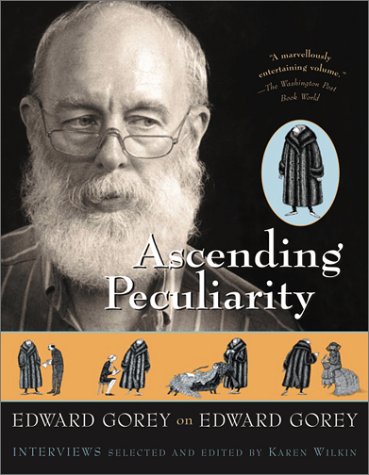 We can understand with the previously mentioned that these North American and European festivals have survived over the centuries; cause by the positive social and psychological impact on generations. Doubtless, Halloween has been an opportunity to bring communities together in a jovial celebration with cultural motivations. Children interact with their friends and neighbors finding a pretext to visit each other. People take advantage of and wear multi-character costumes, making these parties an occasion a boom for genuine expression and creativity. Halloween is a season to explore fantasy and rediscover the games, stories and movies. Being psychologically very beneficial for the emotional and cognitive development of kids. Also, is good to remain the contrary exposure to violent and frightening content can be harmful to mental health. While adults can relive painful memories and traumas related to darkness and death. In societies, the motivations for its realization are significant. The playful ingenuity of minors induces adults to remember their childhood and with the affective environment that is communicated, people take advantage and reconnect with friends and family. The houses are spooky decorated. Each corner integrates a funny episode while a lot of commercial and charitable events call and encourage the neighborhood spirit.
We can understand with the previously mentioned that these North American and European festivals have survived over the centuries; cause by the positive social and psychological impact on generations. Doubtless, Halloween has been an opportunity to bring communities together in a jovial celebration with cultural motivations. Children interact with their friends and neighbors finding a pretext to visit each other. People take advantage of and wear multi-character costumes, making these parties an occasion a boom for genuine expression and creativity. Halloween is a season to explore fantasy and rediscover the games, stories and movies. Being psychologically very beneficial for the emotional and cognitive development of kids. Also, is good to remain the contrary exposure to violent and frightening content can be harmful to mental health. While adults can relive painful memories and traumas related to darkness and death. In societies, the motivations for its realization are significant. The playful ingenuity of minors induces adults to remember their childhood and with the affective environment that is communicated, people take advantage and reconnect with friends and family. The houses are spooky decorated. Each corner integrates a funny episode while a lot of commercial and charitable events call and encourage the neighborhood spirit.
 A that popular magic invites you to dress up that moment of enjoyment, which is why many wear their outfits, outfits loaded with imagination. Dressing up can be a way to explore fantasy and return to the innocence of childhood. People experiment with original characters and roles. Unleashing your creativity and personal expression. They connect with other people who are in disguise. Appropriating less everyday themes and an artistic sense of seeing the world. Hiding your identity, for instance, or reinforcing it for a wonderful moment.
A that popular magic invites you to dress up that moment of enjoyment, which is why many wear their outfits, outfits loaded with imagination. Dressing up can be a way to explore fantasy and return to the innocence of childhood. People experiment with original characters and roles. Unleashing your creativity and personal expression. They connect with other people who are in disguise. Appropriating less everyday themes and an artistic sense of seeing the world. Hiding your identity, for instance, or reinforcing it for a wonderful moment.
 In the spectrum of popular festivities, we can see that carnivals and days of the dead seem to exchange similar aspects for Halloween parties. Because of the presence of costumes and allusions to the deceased. But on the contrary, Halloween is nothing mournful and offering like the Day of the Dead, it haven’t the function of a popular spectacle, with processions, dances and full of permissiveness as Mardi Gras carnival. Halloween, on its eve of all saints, contains concepts of sweetness and fear. A taste of joyful melancholy wrapped in fantasies and superstition. About candies, it is good to remember that they are a temporary source of energy because they contain sugars; but we must portion responsibly them, as they can contribute to overweight, dental problems and a challenge for diabetics. So it is important to celebrate with a moderate consumption. It’s good to opt for fruits, nuts, and other low-carb, low-sugar snacks. Too much sweetness can hurt.
In the spectrum of popular festivities, we can see that carnivals and days of the dead seem to exchange similar aspects for Halloween parties. Because of the presence of costumes and allusions to the deceased. But on the contrary, Halloween is nothing mournful and offering like the Day of the Dead, it haven’t the function of a popular spectacle, with processions, dances and full of permissiveness as Mardi Gras carnival. Halloween, on its eve of all saints, contains concepts of sweetness and fear. A taste of joyful melancholy wrapped in fantasies and superstition. About candies, it is good to remember that they are a temporary source of energy because they contain sugars; but we must portion responsibly them, as they can contribute to overweight, dental problems and a challenge for diabetics. So it is important to celebrate with a moderate consumption. It’s good to opt for fruits, nuts, and other low-carb, low-sugar snacks. Too much sweetness can hurt.
 It is very important to remember within the Halloween celebrations the idea of confronting fear. One of the most recurring ideas that transcends the purpose of popular celebration is the idea of overcoming fears. There are many ways to face fear, thus getting infinite rewards throughout our personal activity. Some methods that we use in our interaction with fears are gradual exposure to fearful situations or objects. Change our thinking, preconceptions. Replace negative and distorted thoughts with realistic and positive thoughts. Practice relaxation and get rid of stressful states and anxiety induced by fear. Sometimes solving problems is just about breathing and finding the rhythm. When you control your mind you manage the body.
It is very important to remember within the Halloween celebrations the idea of confronting fear. One of the most recurring ideas that transcends the purpose of popular celebration is the idea of overcoming fears. There are many ways to face fear, thus getting infinite rewards throughout our personal activity. Some methods that we use in our interaction with fears are gradual exposure to fearful situations or objects. Change our thinking, preconceptions. Replace negative and distorted thoughts with realistic and positive thoughts. Practice relaxation and get rid of stressful states and anxiety induced by fear. Sometimes solving problems is just about breathing and finding the rhythm. When you control your mind you manage the body.
 Another tactic is to talk. Finding understanding and help from someone close or from a therapist allows us to manage fear and not fall into madness. It is opportune to remember that the fear of appearances, ridicule and superstitions can dismiss and controlled in the long term, with valuable perspectives. Because these behaviors feed on negative thoughts, biases, and cognitive distortions. From not meditating and increasing physical and mental tension from frequent conflict situations. For this reason, if our fears are turning out of phobias and go beyond a few unknown situations to frequent threatening sensations, it is appropriate to be assisted by a trained professional. As soon as posible.
Another tactic is to talk. Finding understanding and help from someone close or from a therapist allows us to manage fear and not fall into madness. It is opportune to remember that the fear of appearances, ridicule and superstitions can dismiss and controlled in the long term, with valuable perspectives. Because these behaviors feed on negative thoughts, biases, and cognitive distortions. From not meditating and increasing physical and mental tension from frequent conflict situations. For this reason, if our fears are turning out of phobias and go beyond a few unknown situations to frequent threatening sensations, it is appropriate to be assisted by a trained professional. As soon as posible.
 Well, fear in this case is presenting itself as a pathology that interferes with daily life, bringing limits to our capacity, performance and freedom. All fear is part of human nature. It is not bad at all and it drives certain benefits to our fulfillment. When we overcome it, it’s a normal reaction. It makes us better because we test our courage and ability to face cramped situations. Conquering fear is leaving your comfort zone and making your way through each of the challenges that arise. Build confidence and be stronger than before. Perhaps we must learn more about fear.
Well, fear in this case is presenting itself as a pathology that interferes with daily life, bringing limits to our capacity, performance and freedom. All fear is part of human nature. It is not bad at all and it drives certain benefits to our fulfillment. When we overcome it, it’s a normal reaction. It makes us better because we test our courage and ability to face cramped situations. Conquering fear is leaving your comfort zone and making your way through each of the challenges that arise. Build confidence and be stronger than before. Perhaps we must learn more about fear.
 The redesign of awe helps us set higher standards. If we are not sure, we feel afraid, but insecurity is an emotion that helps us to understand the situation intuitively, and to decide if we should move, prompting us to compete better in search of more successes. Fear is a personal competition and a challenge for ourselves. It leads us to face risks and make risky decisions to find success. Contrary, if we allow ourselves to be dominated by fear, there is the possibility of stopping completely. Fear always is a sign and incentive for new goals. We cannot afford to feel small in front of our rivals. By avoiding this feeling, you risk retarding our true personal growth. Great part of the fears are the effect of inventions. Attempts of manipulation of third parties. They are not invisible threats to our lives. We must be open to fear, but find our place through reason. With good emotional control, we can turn fear into an incentive that pushes us to change.
The redesign of awe helps us set higher standards. If we are not sure, we feel afraid, but insecurity is an emotion that helps us to understand the situation intuitively, and to decide if we should move, prompting us to compete better in search of more successes. Fear is a personal competition and a challenge for ourselves. It leads us to face risks and make risky decisions to find success. Contrary, if we allow ourselves to be dominated by fear, there is the possibility of stopping completely. Fear always is a sign and incentive for new goals. We cannot afford to feel small in front of our rivals. By avoiding this feeling, you risk retarding our true personal growth. Great part of the fears are the effect of inventions. Attempts of manipulation of third parties. They are not invisible threats to our lives. We must be open to fear, but find our place through reason. With good emotional control, we can turn fear into an incentive that pushes us to change.
 Fear does not appear without reason. It originates from things that scare because of their appearance and our ignorance. Sometime people avoid thoughts of loss and failure as experiences out of fear. However, avoiding does not help much, since we do not prepare ourselves or test our resistance to face the problems and the wounds that do not heal become infected. Avoiding is sometimes failing, and we become victims of fear. By analyzing our fear, we can create a timely response to present and future situations. Thus, fear helps us to be proactive. Fear forces us to sharpen our senses, thanks to which we can pay more attention to the challenges of survival. Protecting ourselves and being alert about when to be cautious or bold.
Fear does not appear without reason. It originates from things that scare because of their appearance and our ignorance. Sometime people avoid thoughts of loss and failure as experiences out of fear. However, avoiding does not help much, since we do not prepare ourselves or test our resistance to face the problems and the wounds that do not heal become infected. Avoiding is sometimes failing, and we become victims of fear. By analyzing our fear, we can create a timely response to present and future situations. Thus, fear helps us to be proactive. Fear forces us to sharpen our senses, thanks to which we can pay more attention to the challenges of survival. Protecting ourselves and being alert about when to be cautious or bold.
 Fear is loyal ally to listen properly. There will be times when fear will say now or never, and other times when we will hear, we can let time pass. These points serve as a guide to deal and plan the next steps. Learning to handle the feeling of fear makes us useful people and we are more existentially productive. The fear of immobility is the energy that best serves when we chasing dreams. We must associate fear with opportunity, because each experience is worthy if we keep its lights and its shadows. Feel how it pushes us to go further, to see the evolution of the challenges faced and the path traveled. Overcome our inner monsters. Scare away the pests that want to hit our crops. Do not succumb to the extortion of wicked intentions
Fear is loyal ally to listen properly. There will be times when fear will say now or never, and other times when we will hear, we can let time pass. These points serve as a guide to deal and plan the next steps. Learning to handle the feeling of fear makes us useful people and we are more existentially productive. The fear of immobility is the energy that best serves when we chasing dreams. We must associate fear with opportunity, because each experience is worthy if we keep its lights and its shadows. Feel how it pushes us to go further, to see the evolution of the challenges faced and the path traveled. Overcome our inner monsters. Scare away the pests that want to hit our crops. Do not succumb to the extortion of wicked intentions

 Indeed, Halloween is not a holiday. But it is a splendid party that is being prepared days before its climactic date of October 31. Today this party has not lost relevance and its practice is already spreading by contagion to regions such as Spain, Venezuela, Chile, Argentina and Peru. Added to the previous practices in our days, the folklore is more extensive, haunted houses and visited thematic parks. You see big movie rallies taking place many premieres. The parties invade bars, leisure clubs and fairs. All kinds of industries, businesses and stores direct their efforts to meet the demand for these magical ones. That sweet and superstitious, childish and terrifying spirit conquers a relatively recent phenomenon, such as social networks. That desire for comedy, dancing and impersonation seems like a Halloween appropriation. This desire to influence and record oneself with a certain grotesque ingenuity seems like an appropriation derived from the autumnal festivity.
Indeed, Halloween is not a holiday. But it is a splendid party that is being prepared days before its climactic date of October 31. Today this party has not lost relevance and its practice is already spreading by contagion to regions such as Spain, Venezuela, Chile, Argentina and Peru. Added to the previous practices in our days, the folklore is more extensive, haunted houses and visited thematic parks. You see big movie rallies taking place many premieres. The parties invade bars, leisure clubs and fairs. All kinds of industries, businesses and stores direct their efforts to meet the demand for these magical ones. That sweet and superstitious, childish and terrifying spirit conquers a relatively recent phenomenon, such as social networks. That desire for comedy, dancing and impersonation seems like a Halloween appropriation. This desire to influence and record oneself with a certain grotesque ingenuity seems like an appropriation derived from the autumnal festivity.
The platforms that resonate the most have the same creativity that reuses identity, but they always try to be original and droll. Edgy looking for their personifications to be faithful to their audience and exchanging stories. People usually generate short and highly addictive and providing a feeling of immediate gratification through interaction with other users and always gather for the sweet likes.
Social media like Halloween celebrations are a fun and light way to pass the time, especially in times of boredom, uncertainty, and fear. Both events are business opportunities, with different schemes and frequencies of course, but with a wide scope. Many people promote products and services through these means, developing their brand or career in entertainment and advertising. Or creating easy tutorials and experience behind a screen, but with a more instantaneous interaction between the creator and the viewer keeps that same mysterious character of a costume. Inside, an outgoing party without sacrificing solitude. An armored give. For humanity always celebrates wishes as a common joy. The desire to be accepted and valued through sharing. While also acknowledging others, too. It is the supreme desire to have genuine fun. The demanding desire to share knowledge, teach, and help. The possibility of connecting with people of similar interests and values, becoming part of a community with an audience, and innovative ideas. Halloween culture lives on. It reflected and integrated into our time with originality and as a fun escape. Like an abduction of the quotidian.
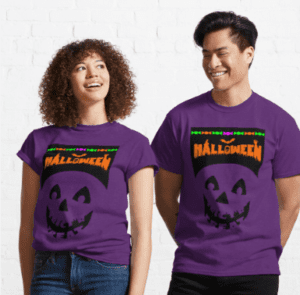 T-Shirt Halloween Candyline Mr. Paintman
T-Shirt Halloween Candyline Mr. Paintman
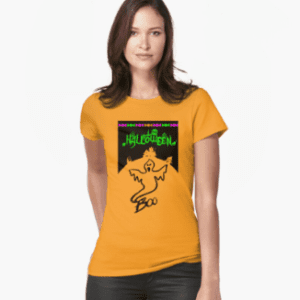 T-Shirt Halloween Candyline Mr. Paintman
T-Shirt Halloween Candyline Mr. Paintman
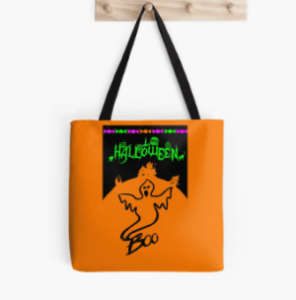 Tote Bag Halloween Candyline Mr. Paintman
Tote Bag Halloween Candyline Mr. Paintman
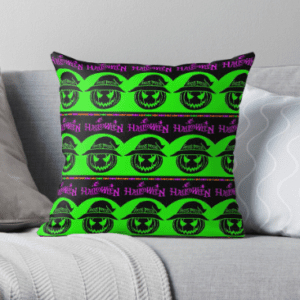 Pillow Halloween Candyline Mr. Paintman
Pillow Halloween Candyline Mr. Paintman
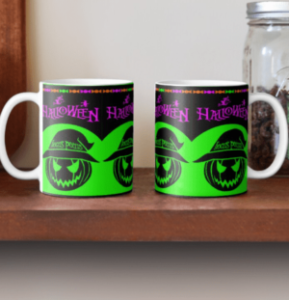 Mugs Halloween Candyline Mr. Paintman
Mugs Halloween Candyline Mr. Paintman
 Cup Monster inside me Mr. Paintman
Cup Monster inside me Mr. Paintman
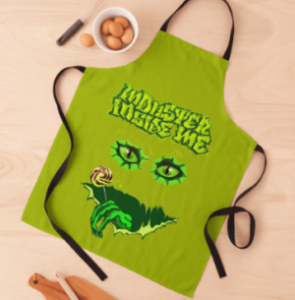 Apron Monster inside me Mr. Paintman
Apron Monster inside me Mr. Paintman
 Pink Hat Sweet fear tonight Mr. Paintman
Pink Hat Sweet fear tonight Mr. Paintman
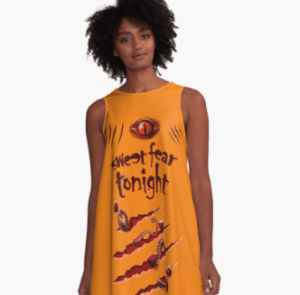 Dress Sweet fear tonight Mr. Paintman
Dress Sweet fear tonight Mr. Paintman
